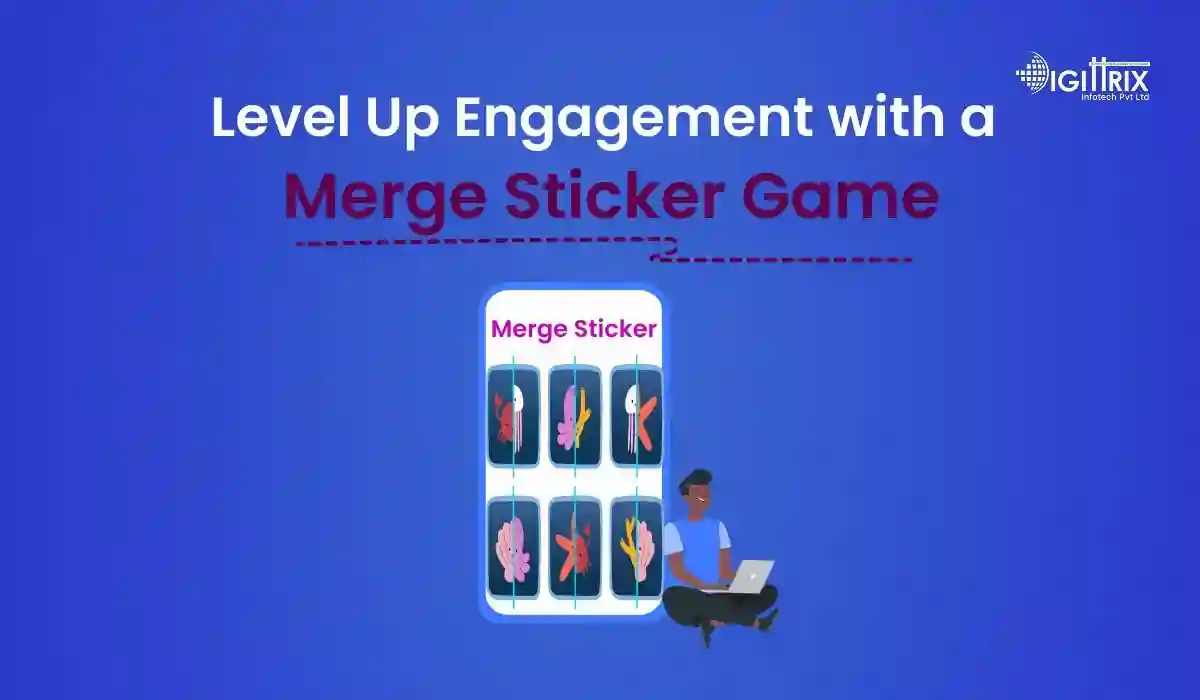Merge and casual games dominate mobile gaming, with 65% of players favoring relaxing, low-pressure gameplay like puzzles, stickers and merge mechanics across Android and iOS.
Highlights
An enthusiastic developer and skilled business management expert with over a decade of experience in the field

In the world of mobile entertainment, casual games continue to hold a strong position. Among these, Merge Sticker Games have found a loyal audience due to their simple mechanics, relaxing gameplay, and satisfying rewards. Whether you're a game enthusiast, a startup, or a company looking to create a popular mobile title, this guide explains how to build a successful and fun Merge Sticker Game App from the ground up.
Let’s walk through the development journey from idea to launch using a detailed and practical approach that’s easy to follow.
Building a fun game app? Check Digittrix's guide to color sorting game development for expert tips!
A Merge Sticker Game typically features a grid where players combine identical stickers (like animals, food, or emojis) to create upgraded versions. These sticker evolutions can be anything — from a cupcake turning into a birthday cake to a dragon egg becoming a crimson dragon.
Games like EverMerge, Merge Mansion, and DesignVille popularized this format with themes like mystery, gardens, cooking, and even tropical adventures.
Merging is addictive because it’s simple, satisfying, and visually delightful. And when paired with fantasy tales, fables, or adventures, it becomes even more engaging.
Define your game’s sticker universe. Will you go with magical creatures like elves, monsters, or fairyland friends? Or will it be everyday objects like food from a restaurant, cafe, or hotel?
Ask the following:
Your decisions here will influence design, coding, monetization and even marketing.
A Game Design Document (GDD) helps organize your ideas. It doesn’t have to be technical, but should include:
A solid GDD helps game app developers and designers stay aligned.
Decide whether you want to build the game for Android, iOS, or both. If you're starting small Android game development is a good option due to its large user base and easier app publishing process on Google Play.
Cross-platform engines like Unity or Godot allow you to build one codebase for both Android and iOS. If you're hiring a game app development company, check whether they work with cross-platform tools. The Business of Apps report shows that 65% of mobile gamers enjoy relaxing puzzle or merge games across Android and iOS platforms.
Here are common tools and frameworks used in Merge Sticker Game Development:
You can even explore Golang, Swift, HTML5, JavaScript, Lua, Python, and React for unique features and extensions.
This is where development begins. Your game app development partner or team should focus on the following:
The central function is combining two similar stickers into one higher-level version. For example, merging two ice cream stickers becomes a double scoop, then a triple scoop, and so on.
A 5x5 or 6x6 grid is standard. Make sure the grid responds smoothly to drag-and-drop motions and provides visual feedback when a merge happens.
Players should be rewarded regularly with coins, hints, new stickers or unlockable levels to keep them motivated.
Graphics play a big role in keeping the game fun. Sticker designs should be visually appealing and clear enough for players to recognize at a glance.
Important graphic elements include:
If you don’t have an in-house design team, many on-demand app development companies offer design support too.
Sound adds personality to your game. Use satisfying click or pop sounds when users merge stickers. Calm or cheerful background music helps build the game's mood and keeps users focused.
Just be sure the sounds aren’t too loud or repetitive, or they’ll push users to mute the game.
The interface should be clean and intuitive. Keep everything visible on the screen — points, goals, coin count, and sticker inventory. Avoid long tutorials. Use a short intro that lets players jump in quickly.
Don't forget to add:
Monetization in mobile game development should not interrupt the gameplay experience. Here are a few strategies:
Be transparent. Let users play freely, but give them optional purchases to upgrade their experience.
Before launch, the game needs to be tested by multiple people. Testing helps you find:
Use internal testers or a small group of beta users. Collect feedback and make improvements. A game app development company may offer Quality Assurance (QA) services to handle this stage thoroughly.
Once your Merge Sticker Game App is ready, it’s time to publish it. For Android, use Google Play Console. For iOS, use App Store Connect. According to Data.ai, casual games account for 78% of all mobile game downloads in global app stores today.
Requirements include:
Also, prepare your app listing for keywords like “merge game,” “casual game,” “fun sticker game,” or “sticker match game” to attract downloads.
To reach players, consider promoting through:
You can also submit your game to game review websites or offer giveaways to create buzz.
If you’re working with a mobile game development company, they may offer post-launch marketing assistance too.
After launch, keep checking user reviews, crash reports, and analytics data. Track how many users return daily, how long they play, and when they leave the game.
Update your game regularly with:
This helps keep players interested and brings them back.
Once your game has gained players, look for opportunities to scale:
A trusted game app developer team can help with updates and long-term support Statista information shows that Merge game titles saw 34% year-over-year growth in player engagement during 2023.
If you're not a developer yourself, working with a game app development company simplifies the entire process. They can manage coding, artwork, sound, testing, and launch support while you focus on content and ideas.
Look for developers who have experience in game app development and understand the casual gaming market. Always check their portfolio and reviews before starting.
Creating a Merge Sticker Game App is a fun and rewarding process when done right. By following these clear steps — from idea, planning, development, to launch — you can bring your sticker game vision to life.
The casual gaming market continues to grow, and users are constantly searching for easy-to-play, satisfying mobile games. With the right design, smart development, and good marketing, your game can find a solid audience.
Whether you're working with a game app development company, building it yourself, or hiring a freelance team, your project's success lies in simplicity, regular updates, and attention to user satisfaction.
The popularity of Merge Sticker Game apps is growing rapidly, as users are drawn to their satisfying mechanics, creative visuals, and casual yet addictive gameplay. In 2025, businesses can capitalize on this trend by developing engaging merge games that combine simple logic with vibrant sticker themes to keep players entertained and coming back for more.
If you're planning to build a merge sticker game, collaborating with a professional mobile game development company is key. At Digittrix, we provide end-to-end game development services—from ideation to app launch, ensuring seamless performance, scalable design, and monetization-ready features. Whether you’re inspired by trending merge games or have an amazing idea in mind, our expert game developers will bring your idea to life with innovation and technical excellence.
Want to explore Merge Sticker Game Development or understand the cost involved in building your puzzle game app? Contact Digittrix at +91 8727000867 or email us at digittrix@gmail.com for a comprehensive consultation.

Do you need help in Mobile App development?




Join over 1500+ businesses we've already helped!
A simple version can take 2-3 months, while a feature-rich one with animations, sounds, and monetization features might take 4-6 months.
Unity is the most widely used engine for 2D casual games. It works for both Android and iOS platforms.
You can add rewarded ads, in-app purchases, and offer special item bundles to generate revenue.
Yes. Many experienced game app developers specialize in mobile and casual games. Choose one based on experience, reviews, and past work.

©2025Digittrix Infotech Private Limited , All rights reserved.